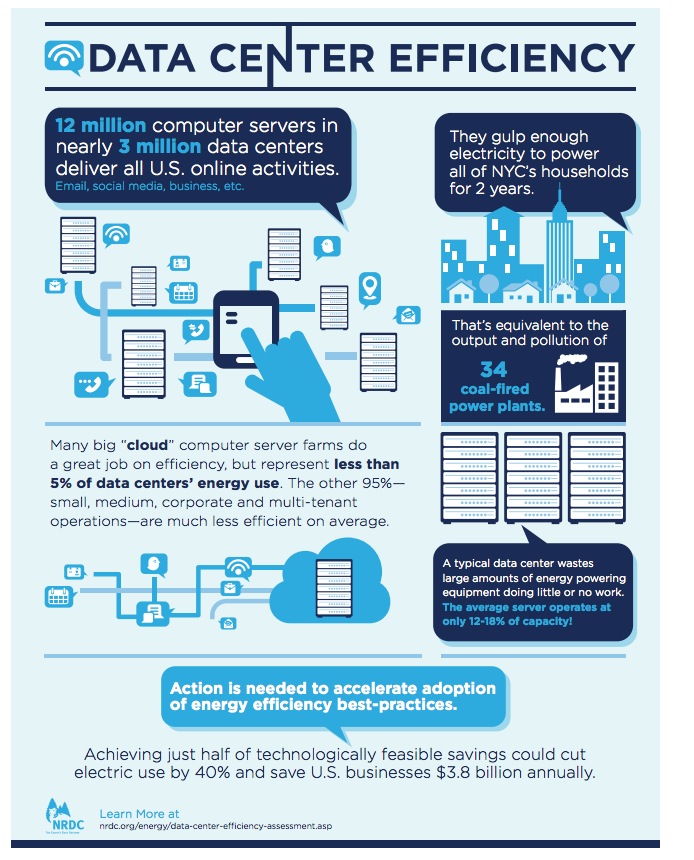NATURAL RESOURCES DEFENSE COUNCIL
Executive Summary
Data centers are the backbone of the modern economy, from the server rooms that power small- to medium-sized organizations, to the enterprise data centers that support American corporations, to the server farms that run cloud computing services hosted by Amazon, Facebook, Google, and others. However, the explosion of digital content, big data, e-commerce, and Internet traffic is also making data centers one of the fastest-growing users of electricity in developed countries, and one of the key drivers in the construction of new power plants in the United States.
While most media and public attention focuses on the largest data centers that power so-called cloud computing operations—companies that provide web-based and other Internet services to consumers and businesses—these hyper-scale cloud computing data centers represent only a small fraction of data center energy consumption in the United States.
As NRDC initially found in its groundbreaking 2012 analysis, Is Cloud Computing Always Greener? Finding the Most Energy and Carbon Efficient Information Technology Solutions for Small- and Medium-Sized Organizations, smaller server rooms and closets are responsible for about half of all U.S. server electricity consumption—but 50 percent of that is wasted due to lack of awareness and incentives to make them more efficient. There remains a critical need for action, including developing utility incentive programs to reduce waste in the massive amounts of electricity used by data centers small and large.
In 2013, U.S. data centers consumed an estimated 91 billion kilowatt-hours of electricity. This is the equivalent annual output of 34 large (500-megawatt) coal-fired power plants, enough electricity to power all the households in New York City twice over. Data center electricity consumption is projected to increase to roughly 140 billion kilowatt-hours annually by 2020, the equivalent annual output of 50 power plants, costing American businesses $13 billion per year in electricity bills and causing the emission of nearly 150 million metric tons of carbon pollution annually.
If just half of the technical savings potential for data center efficiency that we identify in this report were realized (to take into account the market barriers discussed in this report), electricity consumption in U.S. data centers could be cut by as much as 40 percent. In 2014, this represents a savings of 39 billion kilowatt-hours annually, equivalent to the annual electricity consumption of all the households in the state of Michigan. Such improvement would save U.S. businesses $3.8 billion a year.
There has been significant progress in data center
efficiency over the past decade, with shining examples of
ultra-efficient server farms run by the likes of Google and
Facebook. But how efficient, really, is the typical data center
in the United States? What are the key opportunities for
further efficiency gains, and what are the main barriers to
capturing these opportunities? Further, while projections of
overall industry growth and its energy and carbon impacts
remain elusive, even less is known about the makeup of the
sector by data center type and the impact this may have on
future carbon emissions. These are the questions that NRDC
and Anthesis set out to answer in this extensive survey by
interviewing more than 30 industry stakeholders and experts
and reviewing the latest industry literature.
Much of the progress in data center efficiency over the past
five years has occurred in the area of facility and equipment
efficiency. However, little progress has been achieved in
server operation efficiency, particularly in terms of server
utilization. In addition, progress remains uneven across the
different segments of the data center market. This study
therefore focuses on assessing the current situation, the
opportunities and the barriers related to server utilization
efficiency, and the ways in which these opportunities and
barriers vary across different segments of the data center
market, particularly with regard to the multi-tenant data
center business model.
This study found that while the largest public-facing
companies providing cloud computing services typically
run their data centers very efficiently, progress on energy
efficiency has slowed in other types of data centers. Most
significantly, servers are being used very inefficiently,
consuming power 24/7 while doing little work most of the
time. This is due to a variety of factors, such as these:
- Peak provisioning: Data center operators install enough equipment to handle peak annual load, and then some, but do not power down unused equipment during the majority of the time when it is not needed.
- Low deployment of virtualization technology (which allows the consolidation of workloads onto fewer servers) across the entire server fleet.
- “Comatose” servers: A large number of servers that are no longer being used still gulp energy 24/7 because no one is decommissioning them or is even aware that they’re no longer used.
Download full version (PDF): Data Center Efficiency Assessment
About the Natural Resources Defense Council
www.nrdc.org
“The Natural Resources Defense Council is an international nonprofit environmental organization with more than 1.3 million members and online activists. Since 1970, our lawyers, scientists, and other environmental specialists have worked to protect the world’s natural resources, public health, and the environment. NRDC has offices in New York City, Washington, D.C., Los Angeles, San Francisco, Montana, and Beijing.”
Tags: Data Servers, Energy efficiency, Natural Resources Defense Council







 RSS Feed
RSS Feed